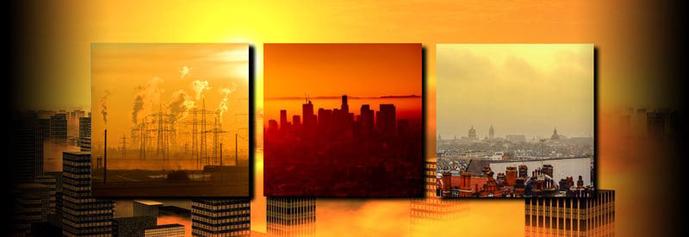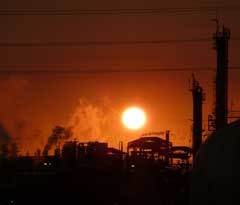Smog: The Silent Threat in Urban Environments

As a result of its brown or yellowish tint, smog can appear very similar and easily be mistaken for "benign" fog or mist. Unfortunately, smog is an entirely different phenomenon and much more hazardous.
Smog is a dense, visible form of air pollution consisting of concentrated levels of smoke, nitrogen, sulfur oxides, and smaller particles. Appearing similar to smoke or fog, it primarily occurs in densely populated regions due to human activity like fossil fuel burning and automotive emissions.
Yes, like fog, it is a semi-transparent layer of air in the atmosphere that reduces visibility. But it is here that the similarities stop.
You will normally see this brownish dirty cloud hovering above a city or industrial area when commuting to work in the morning or late afternoon, especially when there is little wind movement. Sometimes you see this occurrence persisting over a location for days or weeks.
The unsightly image and reduced visibility are not only inconvenient but also hazardous and highly toxic. The worst part is that it is entirely a creation of our own making.
This article examines what smog is, what causes it, and its effect on our health and the environment. We also look at the different types of smog.
Smog Definition
Before we can examine how smog is formed and look at its composition, it's essential to define what exactly smog is:
Smog Definition

Smog is a dense, visible form of air pollution consisting of concentrated levels of smoke, nitrogen, sulfur oxides, and smaller particles. Appearing similar to smoke or fog, it primarily occurs in densely populated regions due to human activity like fossil fuel burning and automotive emissions.
Apart from smoke and emissions, smog contains secondary pollutants that also play a part in the effect on humans and the environment. It may sound a bit vague but will be explained in the next section when we focus on the formation of the two different types of smog.
How Is Smog Formed And The Types Of Smog
While defining smog, the most crucial processes that cause this phenomenon were already briefly highlighted. It also mentioned the two primary forms of this pollution:
- Industrial Smog
- Photochemical Smog
The two types of smog not only consist of different substances, but each one also forms under separate atmospheric conditions. By looking at how each form of smog develops, you will gain a better understanding of how and why smog forms under different circumstances.
1) Industrial Smog
Also known as London or Winter Smog, industrial smog is the type of pollution that originated during the Industrial Revolution as a result of the large-scale burning of coal in industries and households.
Cities like London were severely affected by the burning of coal during the nineteenth and twentieth centuries. It was during the early 1900s that the word "smog" was formed, which was a combination of the words "smoke and fog."

Industrial Smog Formation
The first element that needs to be in place for smog to form is a temperature inversion layer. It is a layer of warmer that lies on top of colder air, preventing the air underneath it from escaping. Inversion can occur naturally or as a result of the Heat Island Effect.
No or minimal wind movement also promotes the creation of smog over a region since it allows the pollution to build up and become more concentrated. A stronger wind would have blown and dispersed the smog away from the location from where it originated.
Cold and moisture-reach air is another necessary component for the formation of industrial smog. The burning of smoke releases smoke particles and sulfur dioxide in the atmosphere, where it combines with the water droplets in the fog to create a thick layer of smog.
2) Photochemical Smog
Also known as Los Angeles or Summer Smog, photochemical smog is the form of pollution that is the result of large scale emissions from the burning of fossil fuels from automobiles and large industries.

Photochemical Smog Formation
Like industrial smog, temperature inversion, as well as little or no wind movement, are required for the formation of smog. Unlike industrial smog, however, this form of pollution requires sunlight and not cold and damp conditions for photochemical smog to form.
The various emissions result in a high volume of nitrogen oxides and VOC (volatile organic compounds) being released into the air. These components form a thick layer at the surface that has the same yellow/brown color of industrial smog but with a different composition.
A secondary and toxic form of pollution is created when photochemical smog reacts with solar radiation. When exposed to oxygen in direct sunlight, a chemical reaction occurs, which turns smog into harmful secondary pollutants, of which ozone is the most dangerous.
Effect Of Smog
Both industrial and photochemical smog can have a severe impact on both the environment and human health. Each type of pollution has its own primary and secondary health and environmental hazards:
Effects Of Industrial Smog
Industrial smog is the original type of fog identified and named during the industrial revolution. Since the conditions in London were so favorable for this form of pollution, we have a clear picture of just how deadly and devastating this form of smog can be.
There are several records of multiple fatalities during periods of heavy smog in the city. The single worst event ever was recorded in December 1952 when the official reports showed that 4 000 people perished (It is estimated that the actual number may be as high 12 000.)
The majority of deaths during this period were a combination of respiratory-related diseases, as well as heart failure.
In general, industrial smog has several short and long-term health effects, of which the vast majority is related to respiratory problems. It is mainly due to the amount of tar and acidity in the air that directly influence and damage the lungs.
Below is a list of some of the direct and related health risks related to industrial smog:
- Respiratory diseases, which include bronchitis, tuberculosis, and pneumonia.
- A compromised immune system in children, which makes them more susceptible to other diseases.
- A strong relationship between smog and cancer has been established, especially those related to the respiratory system.
- Ischemic heart disease, which is the inability of arteries to provide enough oxygen in the blood to the lungs, is another result of exposure to industrial smog.
Apart from these conditions associated with this form of pollution, industrial smog also forms a secondary dangerous and toxic pollutant. Sulfur dioxide mixes with the water moisture in the air, which leads to the formation of acid rain.
Acid rain has a widespread impact which includes:

- Damage to vegetation, including plants and trees, stunting the growth of trees and washing away protective layers on leaves.
- Changing the composition of the make-up of water and soil, making it uninhabitable to both plants and animals.
- Weakening and eroding of infrastructure, including concrete and stone.
- Chronic long disease as an indirect result of sulfur dioxide, which can occur in acid rain.
It is very clear to see the widespread dangers that industrial pollution pose.
Effects Of Photochemical Smog
Even though photochemical smog started to become a severe problem more recently than industrial pollution, it is even more widespread than the former in a majority of cases.
The effects of this form of pollution are as dangerous, if not more so than industrial smog. Photochemical pollution has a similar impact on human health and the environment than its industrial counterpart, especially when it comes to respiratory diseases.

Different forms of respiratory diseases remain the primary and most dangerous effects of smog, including reduced lung function, trouble breathing, and triggering asthma attacks.
As earlier discussed, one of the most hazardous byproducts of photochemical smog is ozone. It contributes to and exasperates existing respiratory problems but also has a widespread effect on other issues, including the environment.
Some of the more serious effects include:
- Reduced lung function and difficulty in breathing in humans and animals.
- Exasperating preexisting respiratory health conditions in children and the elderly.
- Triggering or contributing to asthma attacks.
- Permanent damage to the heart and lungs.
- The damage or destruction of plants sensitive to this form of smog, including tomato and spinach crops.
- The damage and killing of tree leaves when exposed to ozone.
These are just some of the widespread effects of this "modern" form of visible pollution.
(A quick note to clear up some potential confusion. Ozone is essential to protect life on earth against the sun's ultraviolet radiation. But this applies to ozone in the stratosphere where it is far away from direct contact with any human where it is extremely hazardous.)
Conclusion
After reading this article, there should be no doubt left in your mind about the seriousness of smog and how devastating it is, especially in countries that still rely heavily on the burning of fossil fuels for energy.
In this post, we did an in-depth exploration of what smog is, what causes it, and how exactly it affects both human life and the environment.
If you like to be informed whenever a new article is released, and also receive helpful tips & information, you can stay updated by simply following this link .
Until next time, keep your eye on the weather!

